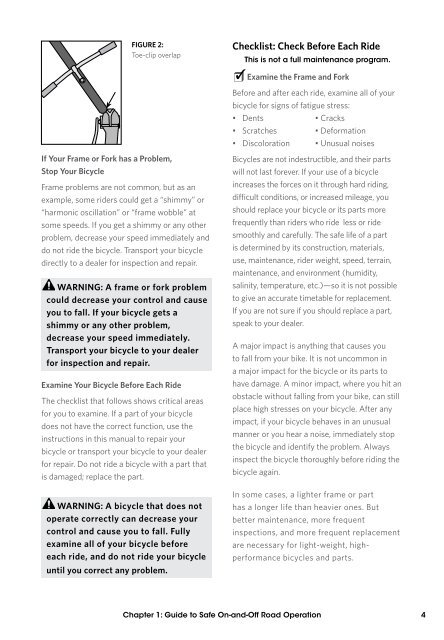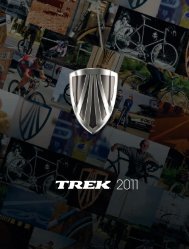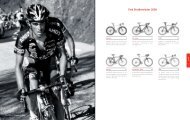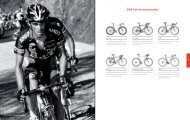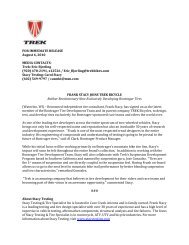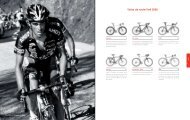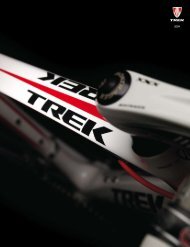Bicycle Owner's Manual - English (.pdf 1.4 MB) - Trek Bicycle ...
Bicycle Owner's Manual - English (.pdf 1.4 MB) - Trek Bicycle ...
Bicycle Owner's Manual - English (.pdf 1.4 MB) - Trek Bicycle ...
Create successful ePaper yourself
Turn your PDF publications into a flip-book with our unique Google optimized e-Paper software.
Figure 2:<br />
Toe-clip overlap<br />
Checklist: Check Before Each Ride<br />
This is not a full maintenance program.<br />
Examine the Frame and Fork<br />
If Your Frame or Fork has a Problem,<br />
Stop Your <strong>Bicycle</strong><br />
Frame problems are not common, but as an<br />
example, some riders could get a “shimmy” or<br />
“harmonic oscillation” or “frame wobble” at<br />
some speeds. If you get a shimmy or any other<br />
problem, decrease your speed immediately and<br />
do not ride the bicycle. Transport your bicycle<br />
directly to a dealer for inspection and repair.<br />
WARNING: A frame or fork problem<br />
could decrease your control and cause<br />
you to fall. If your bicycle gets a<br />
shimmy or any other problem,<br />
decrease your speed immediately.<br />
Transport your bicycle to your dealer<br />
for inspection and repair.<br />
Examine Your <strong>Bicycle</strong> Before Each Ride<br />
The checklist that follows shows critical areas<br />
for you to examine. If a part of your bicycle<br />
does not have the correct function, use the<br />
instructions in this manual to repair your<br />
bicycle or transport your bicycle to your dealer<br />
for repair. Do not ride a bicycle with a part that<br />
is damaged; replace the part.<br />
WARNING: A bicycle that does not<br />
operate correctly can decrease your<br />
control and cause you to fall. Fully<br />
examine all of your bicycle before<br />
each ride, and do not ride your bicycle<br />
until you correct any problem.<br />
Before and after each ride, examine all of your<br />
bicycle for signs of fatigue stress:<br />
• Dents<br />
• Cracks<br />
• Scratches • Deformation<br />
• Discoloration • Unusual noises<br />
<strong>Bicycle</strong>s are not indestructible, and their parts<br />
will not last forever. If your use of a bicycle<br />
increases the forces on it through hard riding,<br />
difficult conditions, or increased mileage, you<br />
should replace your bicycle or its parts more<br />
frequently than riders who ride less or ride<br />
smoothly and carefully. The safe life of a part<br />
is determined by its construction, materials,<br />
use, maintenance, rider weight, speed, terrain,<br />
maintenance, and environment (humidity,<br />
salinity, temperature, etc.)—so it is not possible<br />
to give an accurate timetable for replacement.<br />
If you are not sure if you should replace a part,<br />
speak to your dealer.<br />
A major impact is anything that causes you<br />
to fall from your bike. It is not uncommon in<br />
a major impact for the bicycle or its parts to<br />
have damage. A minor impact, where you hit an<br />
obstacle without falling from your bike, can still<br />
place high stresses on your bicycle. After any<br />
impact, if your bicycle behaves in an unusual<br />
manner or you hear a noise, immediately stop<br />
the bicycle and identify the problem. Always<br />
inspect the bicycle thoroughly before riding the<br />
bicycle again.<br />
In some cases, a lighter frame or part<br />
has a longer life than heavier ones. But<br />
better maintenance, more frequent<br />
inspections, and more frequent replacement<br />
are necessary for light-weight, highperformance<br />
bicycles and parts.<br />
Chapter 1: Guide to Safe On-and-Off Road Operation<br />
4


